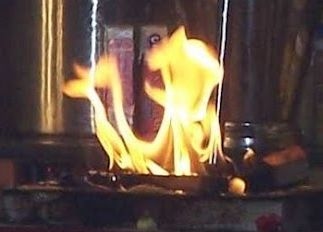The first charitra of Saptashati deals with how one’s I-ness covered by tamas manifests as delusion by the material world, laziness and complacency. Once internal Madhu and Kaitabha are slayed, one overcomes attraction to material things, stops running after them like a bee. One’s spiritual journey starts then.
The second charitra (chapters 2-4) deals with the next stage of rajas. Tamas shows darkness while sattwa shows clarity and light, but both are stable. In contrast, rajas is unstable and shows changes, flux, running around and a play of light and darkness.
When one’s I-ness is covered mainly by rajas, one is no longer in complete darkness. In other words, one is not deluded by the physical world or runs after its objects. One overcomes laziness and complacency and does a lot of sadhana passionately. One exerts oneself. However, one CAN fall victim to Mr. Pride and his associates!
Bull symbolizes strength and excellence. For example, naravrishabha literally means “a bull among men” and it is commonly used to refer to an excellent and capable man. Like bull, buffalo also symbolizes strength and excellence, but with some pride attached!
As a spiritual seeker engages in various practices, pride sets in. One may think greatly of oneself, one’s guru, one’s path, one’s level of sadhana, one’s spiritual experiences, one’s special purpose/mission in life etc. Slaying of that demon symbolizes overcoming that pride and self-importance.
When Mahisha took away what belonged to Indra, Varuna etc, devatas complained to Trimirtis. They all took out their energy/essence, put them together and created Divine Mother. For example, from Vishnu’s energy/essence came her shoulders. From Agni’s energy/essence came her 3 eyes. From Moon’s energy/essence came her breasts. And so on.
This does not mean that she did not exist before and was “created” by them. Divine Mother existed forever, as the energy that was within Supreme Cosmic Being and animated Him. Various aspects of Her infinite energy in fact created various deities. For example, Vishnu who upholds dharma came from her shoulders. Agni who gives clear vision came from her eyes. And so on.
When this great lady reconstructed by all devatas by putting together their own energies went on o fight Mahisha, he sent his army generals. They came with millions of warriors and fought her. This is what these generals stand for:
(1) Chikshura - A variation of chit + kshura = chitkshura. Stands for cut or incomplete knowledge.
(2) Chamara - Means a plume. Stands for lack of firmness and focus in actions (and sadhana), in favor of comfort.
(3) Udagra - Ut+agra. Stands for superiority complex and haughtiness.
(4) Mahahanu - Great jawed. Big jaws are used by animals to crush other animals. Stands for greed and trickery in pursuing one’s agendas.
(5) Asiloma - Means one with knives as body hairs. Stands for selfishness and insensitivity to the well-being of others.
(6) Bashkala - A variation of Vashkala. Vashk means to go. Stands for fickleness and wandering nature.
(7) Parivarita - Means surrounded by others. Stands for wanting followers and supporters.
(8) Bidala - Bit+ala. Bit means abuses and ala means discharging venom. Stands for hurling abuses and insults at others.
When one is proud, the above qualities may take root in one. They in turn make one even more proud and self-absorbed.
Going back to the story, Devi destroyed these generals and their armies and then took on Mahisha himself. Whenever she was about to cut off his head, he escaped it by changing form, once into a lion, then a man, then an elephant and then back into a buffalo. She finally killed him. Then all deities praised her in many ways and she blessed them.
When one tries to overcome mental pride, it takes many forms to escape death. For example, sadhaka may be proud of one’s guru, path, sadhana and experiences. When one truly realizes one’s pride (i.e. divine Mother is about to kill Mahisha!), one may become proud of something else. One may even become proud of one’s realization of pride! It is so difficult to overcome mental pride completely. It takes various forms to escape death! Despite the form taken, it is still Mahishasura (demon of pride). Overcoming pride completely and surrendering to the Divine is very difficult. It requires rajas to be completely overpowered by sattwa.
Just as tamas and rajas are rooted in the physical and mental planes, sattwa is rooted in the spiritual plane (soul) and overcoming it is even more difficult. It is dealt with in the Uttama charitra (3rd charitra).
The deity of the first charitra is Mahakali, who is the power, might and force of cosmic energy. Tamas is rooted in the physical reality and in being deluded by it. Mahakali’s might and force can help one overcome tamas.
The deity of the middle charitra is Mahalakshmi, who is the grace, sophistication and balance of cosmic energy. Rajas is rooted in the mental reality and in giving primacy to constructs and notions of mind (which all serve one’s sense of self-importance in some way or the other!). Mahalakshmi’s grace and balance can help one overcome rajas.
Note: This is the second part of the series. Read the first part at https://www.facebook.com/pvr108/posts/10152522699078284.

